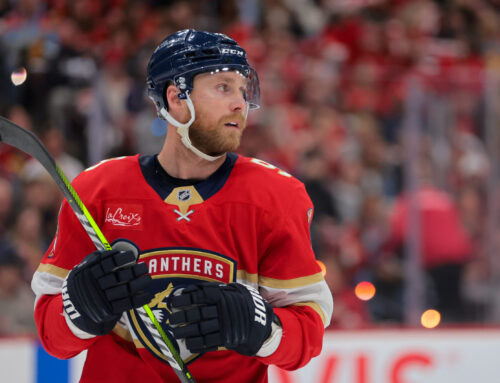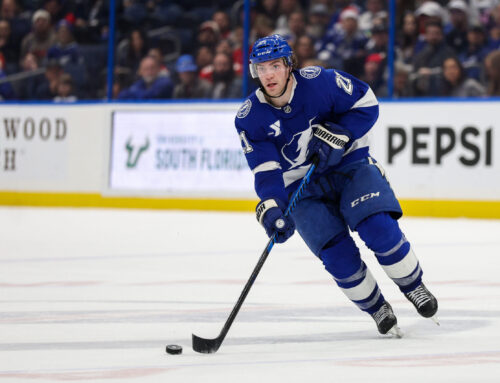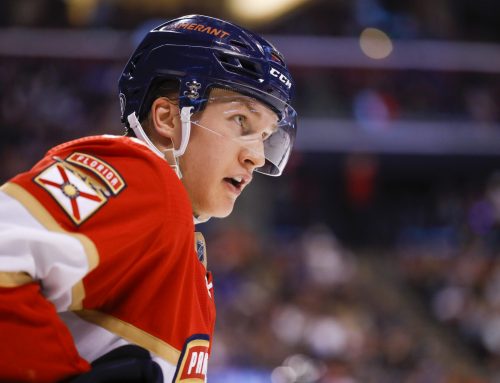Welcome back to Goldipucks and the Three Skaters, a play on words of the Goldilocks and the Three Bears story. Instead of there being three bowls of porridge though, I cover three skaters and declare one too hot (i.e., doing unsustainably better than he should), another too cold (i.e., doing unsustainably worse), and a third “just right” (i.e., producing where he should be). In addition, I also assign each a rating of 1-10, indicating how hot (rated 7-10, where 10 is the most unsustainably hot), cold (rated 1-4, where 1 is the most unsustainably cold), or “just right” (rated 4-7, where 5.5 is the most “just right”) he is.
This is a crucial time of the season, when you're trying to make gains in certain categories or looking to shore up your roster for your league's H2H playoffs. Either way, it's important to know the players whose season-long totals do or – for better or worse – do not represent what they're likely to produce between now and game 82. Fortunately this column is here to tell you what to expect from the three players – Kirill Kaprizov, Kris Letang, and Roope Hintz – who are being covered this week. Go ahead and try to sniff out which one of the three is too hot, which is too cold, and who's just right, then check the write-ups for each to find out if your spidey senses were correct on all three. Stats are current for games played through March 5th.
Kirill Kaprizov (52 games, 26G, 42A, 186 SOG, 17 PPPts, 19:08 TOI, 3:12 PP, 63.9% PP%)
The 2020-21 campaign marked the eagerly awaited NHL debut of Kaprizov, who had been regarded by many to be the best forward not currently in the NHL. And Kaprizov didn't disappoint, tallying 51 points in 55 games, with 16 of those points coming in just his last 13 games. Although many figured he'd parlay that into even bigger success, few might've pegged him for the scoring explosion we're witnessing, which has catapulted him into the top ten in NHL scoring. Is he running hot? Does he have another gear? Or might he be maxed out? Make no mistake – he's every bit for real; however, he probably is at or near his likely ceiling for at least the near-term future.
On the one hand, Kaprizov has done what he's done without anything resembling a top tier NHL center, as no disrespect to Ryan Hartman but it seems abundantly clear that Kaprizov is bringing out the best in him, not vice versa. In a way, Kaprizov is following the playbook of Artemi Panarin, who's made a career out of boosting the production of those around him, or of Jonathan Huberdeau, who's doing the same thing of late, and of Panarin's former Hawk teammate Patrick Kane, who's also been a one man winger show in certain seasons.
The big question has always been if Panarin, Huberdeau or Kane could be even better were they paired with a dynamic center, much like what's occurred with Nikita Kucherov, Alex Ovechkin, and David Pastrnak. When talking about players like Panarin, Huberdeau and Kane though, the key is a team being able to benefit from their talent so as to not need to stack its lines. The result has been Panarin, Kane and Huberdeau being able to score at a 100-110 point rate, which is already where Kaprizov is now.
Yes, Kaprizov reached this level earlier than the other three both in terms of age and NHL experience; but keep in mind that Minnesota will be saddled for the next three seasons with $12.7M, $14.7M and $14.7M in dead cap space due to their buyouts of Ryan Suter and Zach Parise, plus have Kevin Fiala to sign this offseason. As a result, chances are Kaprizov will have to make do without a talented center and, as such, continue to carry his line for the next few seasons, making it less likely he'll be able to reach an even higher scoring echelon.
In addition to this issue, Kaprizov's ice time also acts as somewhat of a points ceiling. If we look at the 90 instances of a player scoring at a 1.2 points per game rate or higher (i.e., just under a 100-point pace) dating back to 2000-01, just ten averaged less of ice time per game than Kaprizov is now, with more than half being over 21:00 per contest. Half those with under 19:00 are part of the Boston trio of Patrice Bergeron, Brad Marchand, and Pastrnak. The others were centers (Evgeni Malkin, Peter Forsberg, Jason Spezza) and wingers with a top tier center (Daniel Sedin, Kucherov). For Kaprizov to even be above a 100-point pace is a testament to his skill as a player given his low – for an elite scorer – overall ice time.
Kaprizov's metrics do suggest though that what we're seeing from his is legit. For starters, his SOG per game is 24% higher than last season yet his SH%, at 14.0%, is only 18% lower. Moreover, among forwards who have higher SOG per game than him this season, a mere one (Auston Matthews) has a higher SH% and the next two highest are Alex Ovechkin and Connor McDavid. Nice company in which to find oneself. Kaprizov also has the second lowest PPPts per game rate among the top ten scorers, so in theory there's room for organic improvement, although maybe not much, as that's an area where the lack of surrounding talent – including not just a center but also no real PP1 QB – could be dragging him down.
Kaprizov's secondary assist rate is 33%, which, if anything, could suggest he's due for more of those in the normal course. Also, his IPPs are not sky high, as his overall IPP sits at 76.4% and his IPP on the PP is 70.8%. His offensive zone starting percentage, although a bit elevated at 56.2%, has ticked down since last season, suggesting if it were to be reduced further his scoring wouldn't suffer.
There are two categories of poolies – those who own Kaprizov, and those who are jealous of the GM in their league who does. Kaprizov has shown he can rise to an elite level essentially through his own talent, which is important due to the Wild's cap constraints over the next three seasons. Yes, he seems to be overachieving in view of his ice time; but if anything, his luck-based metrics should be able to counteract any points he might be expected to lose due to that issue. Although Kaprizov likely won't get better, at least not until the Wild's team improves via its youngsters or when its cap handcuffs are removed, for now his production level is JUST RIGHT, and I'm giving him a rating of 6.0, as I think that he's likely to score at a 100- to 105-point range over the rest of this season and in the next few campaigns.
Kris Letang (53 games, 6G, 43A, 147 SOG, 18 PPPts, 25:48 TOI, 3:29 PP, 76.5% PP%)
Ironically, amidst the chaos of the past couple of campaigns Letang has managed to miss fewer games in a three-season stretch than all the way back to when he entered the league. Somehow, despite being on the other side of 30 he's on track to see his scoring pace, which as I write this sits at 76, rise for the second straight season, with this marking his highest rate since back in 2015-16. But is this level of production sustainable for someone his age, even assuming he stays healthy? I'm afraid the answer is no.
For starters, Letang's past production has tracked one of his metrics very closely, namely PP time. In the two seasons where his scoring rate was – as it is for 2020-21 – above 71 points, his PP times per game were 3:59 and 4:28. His average of 3:29 per game this season is still quite good; but when it has been at or below that number in his past seasons his scoring paces were 67, 71, and 53, for an average of 63. When it was 71, his SOG per game was at 3.17, versus just 2.77 this season.
Speaking of SOG, although Letang's best season, scoring-wise, saw him average roughly the same SOG per game as he is for 2021-22, he only played in 35 games, so we have to take that with somewhat of a grain of salt. His scoring rates for the other campaigns with a SOG rate, as it is this season, under 3.0 per game were 67, 59, 53, 64, 49, 68 and 50. So one great season, versus seven where his scoring rate, although still very good, was an average of 58, which is far below what we're seeing from him this season.
Turning to Letang's metrics, they're definitely elevated. His overall IPP is the highest it's been since he turned 30, and his PP IPP the second highest. The latter is of more concern, as the average over the past four seasons had been 51.2, versus 54.5% this season. That is as surprising as it is unsustainable, due to his age but more so as a result of the Pens fielding a better PP than they've had in ages. While it used to be Letang, Sidney Crosby, Evgeni Malkin and two other forwards who were a steep drop off, now there's Jake Guentzel and Bryan Rust, who are both excellent scorers. Of those four, all but Rust have PP IPPs lower than their normal ranges. As the season further unfolds, the expectation is the PP IPPs of those three will go up while Letang's should, in turn, drop.
Looking at other data, Letang's offensive zone starting percentage and secondary assists percentage don't stand out in a positive or negative way. His overall ice time too is where is usually is; and although he's taking the ice a bit less on the PK as compared to what usually is his norm, there should not be a resulting benefit to his production in view of his OZ% not having climbed.
What about player comparables? From age 24-33, Letang finished with a scoring rate of 0.8 to 1.1 six times. If we focus on defensemen who did so at least four times dating back to 1990-91, we get Brian Leetch (six times) plus Brent Burns, Sergei Gonchar, Al MacInnis and Phil Housley (four times each). Looking at their production from age 34 onward, while the majority scored at a 50- to 60-point pace at least once, only MacInnis even reached the 60s, and he did so twice. Granted, Letang's legs are fresher than most 34 year olds due to having missed so much time due to injury over the years; but when five of the most elite offensive d-men of their eras were unable to produce near what he is doing now at this age, it further calls into question the legitimacy of Letang's scoring rate.
I'm sure most poolies would've figured that Letang's injury issues would only worsen as he aged and, with that, his production would suffer. Yet we're seeing him healthy and on pace for what could be his second-best season. On the surface, it doesn't add up; and in this case what's on the surface is correct. Players cut from his cloth simply aren't this productive this late into their careers, plus Letang's PP Time, SOG rate, and PP IPP suggest he's lucked into points he shouldn't have received. If Letang remains healthy – and with him that is always an if – I'd look for him to score at closer to a 60- to 65-point rate over the rest of the season, making his 2021-22 thus far TOO HOT, and earning him a rating of 9.0.
Roope Hintz (52 games, 23G, 22A, 144 SOG, 16 PPPts, 17:59 TOI, 2:39 PP, 52.0% PP%)
After acclimating well to the NHL over his first two seasons, Hintz exploded for better than point per game output in 2020-21, staking a claim to the first line center role for Dallas in the process. For 2021-22 he's taken a bit of a step back amidst the return of Tyler Seguin. What should be expected from Hintz for the rest of 2021-22 and beyond? Production at least as good as what we saw last season.
For starters, there should be no concern over the presence of Tyler Seguin. Hintz, plus his linemate Jason Robertson, have shown enough in the past two seasons to cement them as top line fixtures, especially given their age and production. Moreover, even when Seguin was put back on PP1 recently, it did not result in Hintz being relegated to PP2.
Why, then, isn't Hintz producing as well as he did last season? Truth is, he should be. His SOG rate is up by more than 25%, yet his SH% is unaffected, showing that he has the ability to be a scoring and playmaking center – more on that below. Again then, if that's the case, why is his scoring rate not only below what it was last season, but under a point per game? What's happening is Hintz's season-long numbers are being dragged down by a slow start which saw him produce only one point in his first ten games, meaning since then he's tallied 44 in 42 contests, for a similar pace as last season. There's also the reality that Hintz, despite already being 25, is just now reaching his 200 game breakout threshold, which is when players usually ascend to new highs in scoring.
Hintz being equally adept at scoring goals as he is in setting them up also bodes well for his production, as he's on pace to produce both 0.4 goals and assists per game in this, just his fourth season. If we look at centers who met both those criteria within one or more of their first four seasons while also scoring – as Hintz is now – at less than a point per game rate and dating back to 2000-21, the names on the list are Elias Pettersson, Auston Matthews, Dylan Larkin, Aleksander Barkov, Seguin, John Tavares, Jonathan Toews, Anze Kopitar, Eric Staal, Evgeni Malkin, Pavel Datsyuk, and Joe Thornton. Needless to say, most of those on that list went on the have very good to superb careers, or are in the midst of doing so.
Hintz also is demonstrating that he's a PP whiz, as he's tied for 32nd in PP scoring among forwards despite only receiving the 78th most PP minutes. Lest one think this might just be a fluke, it was a similar story last season, when he finished tied for 16th in PP scoring among forwards even though his PP minutes ranked him just 107th. The fact that Hintz is scoring at this rate with the man advantage is very much for real; and if Dallas ever decides to lean more heavily on its top unit, Hintz's PP scoring could explode.
Also, after having a 70.2% or higher overall IPP in each of his first three seasons, which as I've noted many times in this column is a superb indicator of a player's ability to become a star, Hintz's is down to 60.8% this season. Despite his PP scoring success, his IPP there is lower than his norm as well at 66.7%. It would be one thing if this was happening last season, which was Hintz's first with truly talented wingers; but he's taking the ice with essentially the same wingers, so decreased IPPs don't add up, and it stands to reason they'll climb over the rest of 2021-22, with his points doing so as well. As for his other metrics, his secondary assist rate is higher than last season but stands at 40.9%, which is just fine for a center, plus his OZ% has ticked down a bit, and we shouldn't be concerned that it remains slightly above 60%, as his line is the offensive focal point on the team.
Hintz is a star in the making, and that would be apparent even if not for extremely favorable player comparisons. He's shooting more yet still accurately, is a PP stud, and his IPPs are below their normal ranges, not to mention his season-long totals being weighed down by a poor start, 60% of which coincided with Jason Robertson being out. Accordingly, Hintz's 2021-22 has been TOO COLD, and we should expect him to score at a rate of 85-90 points over the remainder of the season, and I'd be surprised to see him finish below 90 again in future seasons, giving him a rating of 1.75.
***********************
Questions for Mailbag
My monthly mailbag is in a couple of weeks and is already starting to fill .To get your questions to me, you can (1) private message “rizzeedizzee” via the DobberHockey Forums or, instead, or (2) email admin@dobbersports.com with “Roos Mailbag” as the subject line.





 TOR
TOR EDM
EDM ANA
ANA BUF
BUF PIT
PIT S.J
S.J MIN
MIN DET
DET CBJ
CBJ UTA
UTA STL
STL
